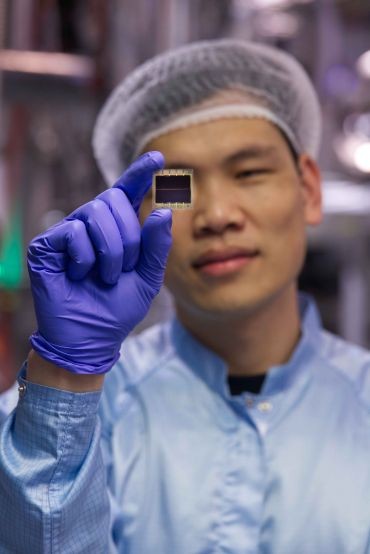
Image: Oxford University Physics
Scientists at the University of Oxford are coating objects such as backpacks, cars and mobile phones with a new material to generate solar power.
The potential of this breakthrough is that increasing amounts of solar power could be generated without silicon-based solar modules.

The Oxford scientists’ new light-absorbing material is, for the first time, thin and flexible enough to be applied to the surface of almost any building or ordinary object. By stacking several light-absorbing layers in a solar cell (known as the multiple junction method), a wider range of the light spectrum is used, allowing more electricity to be generated from the same amount of sunlight.
This thin-film perovskite material has been independently certified by Japan’s National Institute of Advanced Industrial Science and Technology (AIST) and offers energy efficiency of over 27%, matching the performance of conventional single-layer silicon PV for the first time.
Dr Shuaifeng Hu (pictured), a postdoctoral researcher in the Department of Physics at the University of Oxford, said:
During just five years of experimentation with our stacked or multiple junction approach, we have increased energy conversion efficiency from around 6% to over 27%, close to the limit of what can be achieved today with single-layer photovoltaics.
We are convinced that this approach could, over time, lead to significantly higher efficiency of photovoltaic systems of over 45%.
The versatility of the new ultra-thin and flexible material is also crucial – at just over a micrometer thick, it is almost 150 times thinner than a silicon wafer. Previous photovoltaics have generally been applied to silicon sheets, but this one can be applied to almost any surface.
Dr Junke Wang, Marie Skłodowska-Curie Postdoctoral Fellow at the Physics Institute, University of Oxford, said:
We can imagine applying perovskite coatings to wider surfaces to generate cheap solar energy, for example on car roofs and building roofs and even on the backs of mobile phones. If more solar energy can be generated in this way, in the long run it is reasonable to assume that there will be less need to use silicon panels or to build more and more solar farms.
The 40 scientists working on photovoltaics in the Department of Physics at the University of Oxford are led by Henry Snaith, Professor of Renewable Energy. Their pioneering work in photovoltaics, and in particular in the use of thin-film perovskite, began about a decade ago.
Oxford PV, a British company spun off from Oxford University’s physics department in 2010 by Snaith to commercialise perovskite photovoltaics, has recently started mass production of perovskite photovoltaics at its plant in Brandenburg an der Havel near Berlin. It is the world’s first production line for tandem “perovskite on silicon” solar cells.
Read more: Oxford sets new world record for solar panel efficiency
To limit power outages and make your home more resilient, consider solar power with a battery storage system. To find a trusted, reliable solar installer in your area who offers competitive pricing, visit EnergySagea free service to make it easy for you to go solar. Hundreds of pre-screened solar installers compete for your business, ensuring you get high-quality solutions and save 20-30% compared to going it alone. Plus, it’s free to use and you won’t receive any sales calls until you’ve selected an installer and given them your phone number.
You can easily compare your personal solar offers online and get access to unbiased energy consultants who will support you every step of the way. Start now Here. –trustworthy affiliate link*
FTC: We use income generating auto affiliate links. More.

